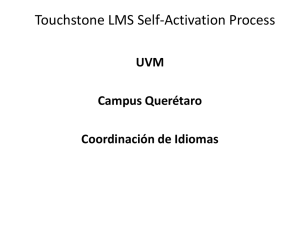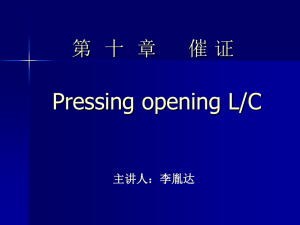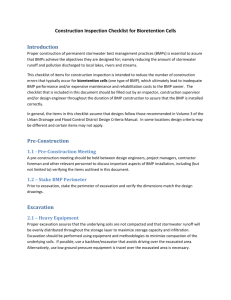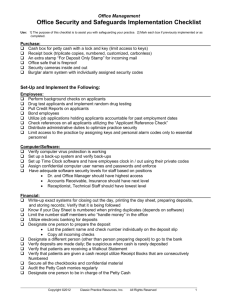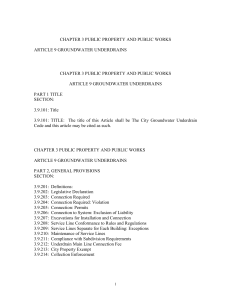Permeable Pavement Construction Checklist
advertisement
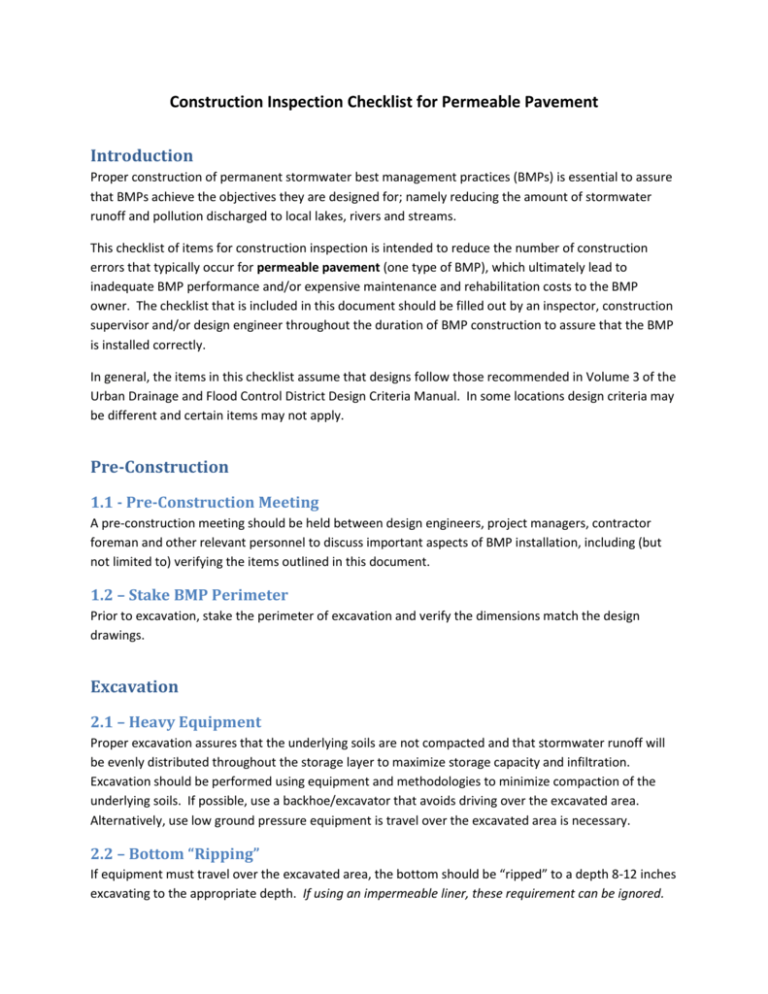
Construction Inspection Checklist for Permeable Pavement Introduction Proper construction of permanent stormwater best management practices (BMPs) is essential to assure that BMPs achieve the objectives they are designed for; namely reducing the amount of stormwater runoff and pollution discharged to local lakes, rivers and streams. This checklist of items for construction inspection is intended to reduce the number of construction errors that typically occur for permeable pavement (one type of BMP), which ultimately lead to inadequate BMP performance and/or expensive maintenance and rehabilitation costs to the BMP owner. The checklist that is included in this document should be filled out by an inspector, construction supervisor and/or design engineer throughout the duration of BMP construction to assure that the BMP is installed correctly. In general, the items in this checklist assume that designs follow those recommended in Volume 3 of the Urban Drainage and Flood Control District Design Criteria Manual. In some locations design criteria may be different and certain items may not apply. Pre-Construction 1.1 - Pre-Construction Meeting A pre-construction meeting should be held between design engineers, project managers, contractor foreman and other relevant personnel to discuss important aspects of BMP installation, including (but not limited to) verifying the items outlined in this document. 1.2 – Stake BMP Perimeter Prior to excavation, stake the perimeter of excavation and verify the dimensions match the design drawings. Excavation 2.1 – Heavy Equipment Proper excavation assures that the underlying soils are not compacted and that stormwater runoff will be evenly distributed throughout the storage layer to maximize storage capacity and infiltration. Excavation should be performed using equipment and methodologies to minimize compaction of the underlying soils. If possible, use a backhoe/excavator that avoids driving over the excavated area. Alternatively, use low ground pressure equipment is travel over the excavated area is necessary. 2.2 – Bottom “Ripping” If equipment must travel over the excavated area, the bottom should be “ripped” to a depth 8-12 inches excavating to the appropriate depth. If using an impermeable liner, these requirement can be ignored. 2.3 – Bottom is Flat and Level The bottom of the cell should be flat and level to allow for even distribution of water throughout the storage layer. If design calls for a sloped bottom to drain storage layer towards an underdrain, this requirement is not applicable. 2.4 – Protection After Excavation Immediately after excavation is complete, place construction sediment control BMPs around the basin to prevent runoff from entering the cell. Sediment control BMPs should only be removed once the upstream catchment is stabilized. 2.5 – Infiltration Testing If facility is “full-infiltration” design, verify that infiltration rates through bottom of the cell are greater than 0.5 inches/hour. Infiltration tests should be conducted using ASTM D3385 or other method approved by inspector/reviewer. If infiltration rates are less than 0.5 in/hr, notify the project engineer immediately for design review. Impermeable Liner The impermeable liner will prevent runoff from infiltrating into adjacent soils and potentially damaging nearby structures. 3.1 - Liner Material Verify that liner material meets the design specifications and is at least 30 mil thick. Verify that liner has no tears prior to and after placement. 3.2 – Liner Attachment Prior to backfilling, provide at least 2 inches of slack above the attachment points to prevent the liner from tearing due to backfill and settling. After backfilling, verify that liner is attached to a concrete perimeter wall according to design specifications. Underdrain System 4.1 – Underdrain Pipe Verify that the underdrain pipe meets design specifications, especially the size and number of slots. 4.2 – Underdrain Wrapping Verify that the underdrain is NOT wrapped (directly) in geotextile fabric to avoid clogging of the underdrain. 4.3 – Underdrain Filter Verify that filter material placed around the underdrain meets the gradation specifications called out in the design. Provide a copy of the filter material gradation test results to design reviewer. 4.4 – Cleanout Locations Verify that at least one cleanout is provided for each underdrain lateral. 4.5 – Cleanout Pipe Verify that cleanout pipes are NOT perforated to avoid short-circuiting of runoff through the cleanout pipes. 4.6 – Cleanout Covers Verify that cleanout covers are installed and watertight. 4.7 – Orifice Plate Verify that the orifice plate is installed at the outlet point of the underdrain system, per design specifications. Aggregate 5.1 – Base Course Verify that base course (typically No. 2 or No. 4 aggregate) has at least 90% fractured faces 5.2 – Bedding Course/Joint Fill Verify that bedding course (typically No. 8, No. 9 or No. 89 aggregate) is washed and has at least 90% fractured faces. Ensure that joints inbetween pavers are filled to the top. This applies only to permeable interlocking concrete pavement installations 5.3 – Compaction Verify that base materials are compacted according to manufacturer and/or design recommendations. Cover/Protection 6.1 – Cover/Protection After installation is completed and while other site construction is occurring, verify that pavement is covered and/or otherwise protected with construction BMPs so that construction runoff does not enter the pavement. Close Out 7.1 – Upstream Catchment Stabilization Verify that construction activities in the upstream catchment have been completed and that landscaped areas have been properly vegetated or otherwise stabilized, prior to removing pavement cover or temporary sediment control BMPs. If the upstream catchment is not stabilized, the pavement may clog rapidly and require complete replacement of pavement. 7.2 – Snow and Ice Control Signage Verify that signage is installed to notify snow removal personnel that snow cannot be stored on top of the permeable pavement and that sand should not be applied for ice control. If design specifications do not call for signage, consult with design reviewer to determine if signage is required. Construction Inspection Checklist for Permeable Pavement Project: ______________________________ Site: __________________________________ Inspector: ____________________________ Company: ______________________________ No. Item/Activity 1.1 Pre-construction meeting held to discuss BMP installation, inspection and checklist BMP perimeter verified and staked 1.2 Pass Fail N/A Date Pre-Construction Excavation 2.1 2.2 2.3 2.4 2.5 Heavy equipment did not travel over excavated area Bottom of cell was “ripped” after excavation Bottom of cell is flat and level Excavated area is protected/surrounded by sediment/runoff control BMPs during construction Infiltration rate verified (“fullinfiltration” design only) Impermeable Liner 3.1 Liner meets design specifications, is at least 30 mil thick and has no tears Notes 3.2 Liner is attached to concrete perimeter wall according to design specification and has at least 2 inches slack prior to backfill Underdrain System 4.1 4.2 4.3 4.4 4.5 4.6 4.7 Verify that underdrain pipe is per design specifications Verify that underdrain is NOT wrapped in geotextile fabric Verify that underdrain filter material gradation meets design specifications Verify at least one cleanout is provided per underdrain lateral Verify that cleanout pipe is not perforated Verify that cleanouts covers are installed and watertight Verify that orifice plate is installed at underdrain discharge point, per design specifications Aggregate 5.1 5.2 5.3 Base coarse (e.g. #2/4) has 90% fractured faces Bedding coarse (e.g. #89) is thoroughly washed Subbase materials are installed and compacted according to manufacturer specifications Cover/Protection 6.1 Verify that pavement is covered and protected from runoff from other site construction activities Close Out 7.1 7.2 Verify that upstream catchment stabilized prior to diverting runoff into bioretention cell Verify that signage is installed according to design specifications
